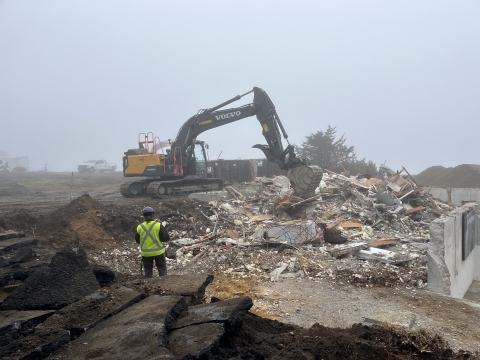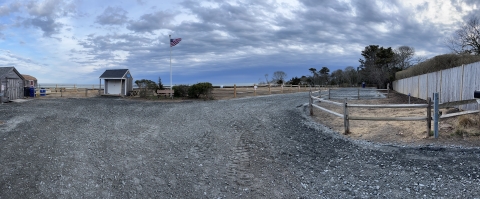Cape Cod has an erosion problem.
The Atlantic Ocean is ravenously gnawing at the shoreline bluff of Morris Island in Chatham, Massachusetts, home to the headquarters of Monomoy National Wildlife Refuge. On the Cape’s southernmost point, erosion has taken between 30 and 45 feet of land every year for the past few years.
The scene is alarming.
As the bluff’s edge has receded inland, Monomoy’s Refuge Manager Rick Nye has faced difficult tasks, preemptively removing structures onsite before they tumble down the bluff and become marine debris. In April 2024, the property's final building standing, its headquarters and visitor center, was removed.
Having carefully considered all options for a path forward, the Service decided not to try and stop Mother Nature, but instead to adapt.
Migratory birds and beaches
Established in 1944, Monomoy National Wildlife Refuge protects nearly 8,000 acres of coastal habitat for migratory birds, mammals and more. It’s one of eight refuges in the Eastern Massachusetts National Wildlife Refuge Complex.
Complex Manager Grace Bottitta-Williamson shared that Monomoy National Wildlife Refuge boasts many claims to fame. It’s globally recognized for its support of numerous species of shorebirds throughout the year. It features the highest concentration of nesting federally listed piping plovers in New England, some of the highest concentrations of spawning horseshoe crabs in the state, and, on South Monomoy Island, the largest gray seal haul-out site on the Atlantic Coast.
Monomoy’s barrier beaches, islets and shoals stretching out into the ocean are a spectacular sight. But spend enough time here, and you’ll witness a landscape in motion.
Erosion is a natural, cyclical process that’s shaped and re-shaped Cape Cod for centuries. Wind and waves move beaches and erode dunes and bluffs, transforming the scene over days, weeks and years.
Boosted by the effects of climate change climate change
Climate change includes both global warming driven by human-induced emissions of greenhouse gases and the resulting large-scale shifts in weather patterns. Though there have been previous periods of climatic change, since the mid-20th century humans have had an unprecedented impact on Earth's climate system and caused change on a global scale.
Learn more about climate change — sea level rise, storm surge and flooding — erosion at Monomoy has accelerated, becoming intense and unpredictable. In 2017, a storm on April Fool’s Day (no joke) broke through the barrier beach that protects the Headquarters property. The gap left behind, now called the “Fool’s Cut,” left the site vulnerable.
The problem’s certainly kept Rick Nye on his toes since he came aboard as refuge manager in June 2021.
“Ever since I got to Monomoy, I knew that my time working here was going to be about addressing this erosion issue,” said Nye.
His first day on the job was coincidentally the same day the National Weather Service balloon-launching station that operated on the island for decades was demolished for safety reasons.
Nye’s seen other structures removed from the property in response to the eroding bluff, including a popular observation deck, stairs for public access to the beach, public restroom, and a dormitory that housed summer interns. A former Coast Guard boathouse, that dormitory stood on the property for more than a century.
No band-aid solutions
Naturally, visitors have questions about what can be done. Why not build a barrier?
Sadly, it’s not that simple.
There are plenty of options when it comes to reinforcing a coast — like revetments, bulkheads and seawalls. But hard structures like seawalls can be astronomically expensive to install and maintain, and even then, there’s no guarantee they will last. Protective barriers can also deflect wave action to adjacent coastal areas, causing damage to nearby properties.
Nature-based solutions, like living shorelines, have seen success in bolstering coastlines with environmentally friendly materials that promote ecological resilience and benefit wildlife.
But the intensity of the wave action at Monomoy would overwhelm a living shoreline, or any other structure structure
Something temporarily or permanently constructed, built, or placed; and constructed of natural or manufactured parts including, but not limited to, a building, shed, cabin, porch, bridge, walkway, stair steps, sign, landing, platform, dock, rack, fence, telecommunication device, antennae, fish cleaning table, satellite dish/mount, or well head.
Learn more about structure of that caliber. No matter how they crunched the numbers, Service staff saw only one feasible path forward: Rather than resist the inevitable, they accepted the change and planned a managed retreat.
The decision aligns with the Resist-Accept-Direct framework, which refuge managers use to address effects of climate change. They can choose among the traditional wildlife management approach of resisting change and restoring habitat, or two alternatives: accepting change and allowing habitats to transition without intervention or directing change by working alongside occurring transformations, to support a variety of fish and wildlife and safeguard nature’s benefits to people.
“To be fiscally and environmentally responsible, we needed to pull our building and staff out of there, before Mother Nature beat us to it”, said Grace Bottitta-Williamson.
Thanks to the outstanding work of a cross-regional maintenance action team, the demolition project was carried out in just two weeks.
Conservation prevails
Weeks ahead of the scheduled demolition, the refuge invited the public to the visitor center for one last open house. Nearly 200 residents came throughout the day to visit, learn about the issue and reminisce about their refuge experiences and connections to the center. Among them were long-time volunteers, a couple who became engaged on the old refuge observation deck and a first-time visitor to the refuge.
Nye and the Monomoy staff understand and share the public’s feelings of sadness and grief. But in conversation with visitors, he also reminds them of the bigger picture.
“While we are temporarily without a building on Morris Island, there are still roughly 8,000 acres of land and waters that we’re continuing to manage for wildlife.”
And hundreds of thousands of shorebirds and other species that thrive thanks to vital refuge habitat.
As they work to acquire and relocate to a new headquarters facility while also gearing up for a busy field season, Bottitta-Williamson and Nye foresee an array of logistical challenges— but they remain determined.
“We’re still here, delivering on conservation.”
The team at Monomoy embody the conservationist spirit: Even as the forces of nature change the landscape under their feet, they remain steady and agile, showing up each day for wildlife.
















